Jump directly to the DIGITAL GALLERY of photos shot with the full frame digital Sony a7ii camera and the ANALOG GALLERY of photos shot with the medium format analog Pentacon Six camera
The Olympia Sonnar
The first Carl Zeiss Jena Sonnar 180mm f2.8 lens was released especially for the Olympic Games 1936 in Berlin, and was called the Olympia Sonnar. At that time, fast films and fast tele lenses were not available in sufficient quality. To enable sharp photographs of moving athletes at the Olympic Games in 1936, a fast Sonnar type tele lens was produced by Carl Zeiss Jena using a fluorite glass element to increase light transmission and to reduce chromatic aberration.
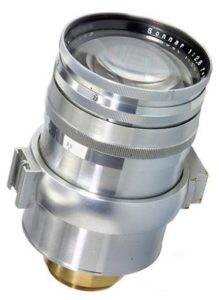
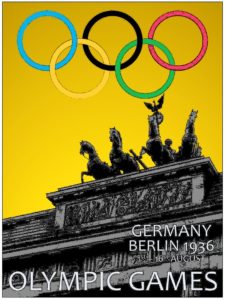
The name Sonnar comes from the German word ‘Sonne‘, which means ‘sun’.
When gifted German optics engineer Ludwig Bertele constructed the Olympia Sonnar, he made history. Probably developed as a cinema lens for Leni Riefenstahl’s propaganda movies, the 1.3 kg lens is the prototype of all modern high-speed sport lenses. With the relatively long focal length and high light transmission, it was the first time that freezing fast movements and spectacular jumps into a photograph became possible. In 1946, Ludwig Bertele moved to Switzerland, where he founded an optical bureau and started to work at Wild Heerbrugg Company (now Leica Geosystems).
In 1961, Carl Zeiss Jena adapted the full frame Olympia Sonnar for the 6×6 medium format and the Pentacon Six camera system. In this article, the descendant lens of the Olympia Sonnar is tested and compared with the classic Canon FD 200mm f2.8 lens and the modern Sony FE 24-240mm zoom lens.
Sonnar types of tele lenses are out of fashion today because a comparable image quality and lens speed can be achieved using cheaper lens constructions with new glass types and without expensive fluorite glass elements. However, the bokeh quality of modern tele lenses is, as a rule, much lower.
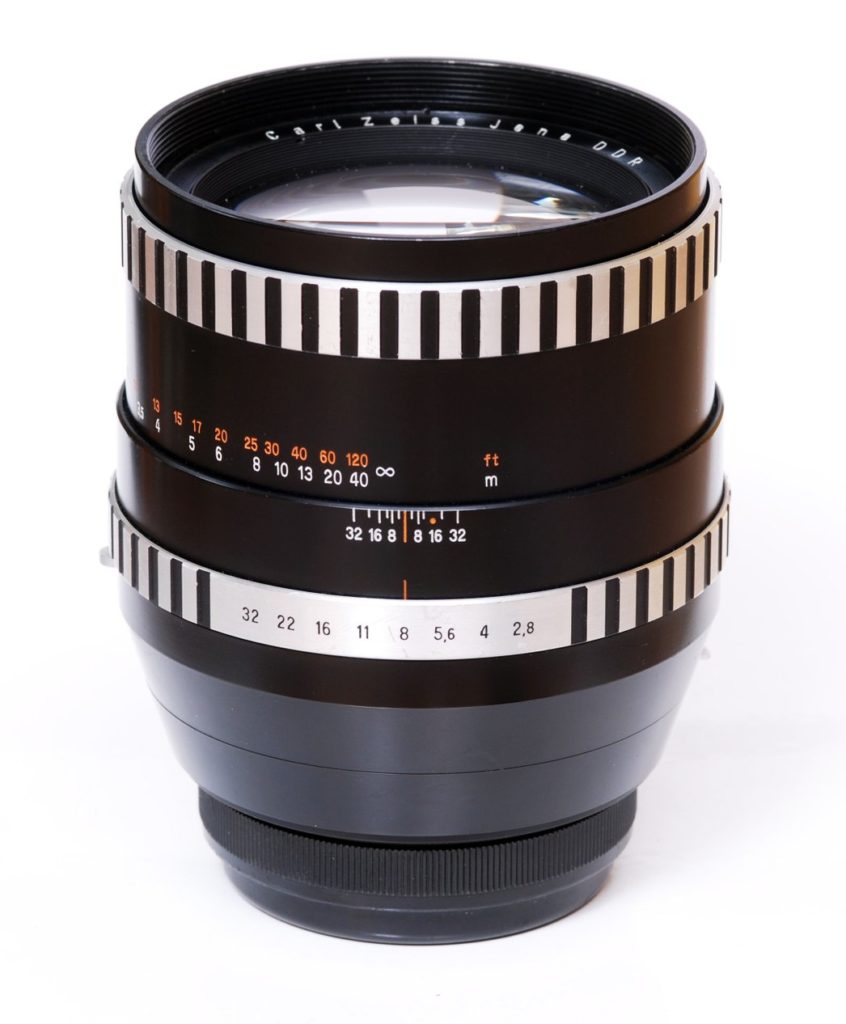
Size matters!
Here we see the vintage 6×6 medium format lens Carl Zeiss Jena Sonnar 180mm f2.8 in the “Zebra edition”, built in 1968, adapted to the full frame camera Sony a7ii:

If you have a camera with a 5-axis in-body image stabilization like the Sony a7ii, your medium format lenses gain a speed advantage because of efficient stabilization, which enables reduced shutter speeds.
Why adapt a medium format lens to the full frame camera?
There are several good reasons to do so:
- Medium format lenses with a high image quality are often underprized because it is less known that medium format lenses can also be adapted to full frame cameras. It is certainly a less common practice, further demonstrated by a much lower number of Internet pages about medium format lens adaptation compared to full frame lens adaptation. See a comparison of the medium format Carl Zeiss Jena Sonnar 180mm f2.8 with the famous full frame lens Nikkor Ai-S 180mm f2.8 here and compare the prices at ebay for both lenses: https://www.photo.net
- Only the “sweet spot” of a lens is used when adapting a medium format lens to a full frame camera; because of the cropping, only the middle part of the glass is in the field of view. This leads to less vignetting and usually to a higher image quality.
- Medium format lenses were produced for more professional use than full frame lenses, so the probability of finding medium format lenses with low image quality is much lower than with full frame lenses. Hence, it is unlikely you’ll find medium format lenses like the full frame Hanimex Hanimar 28mm f2.8 lens, “probably the worst lens in the world“: https://www.youtube.com
- Start to shoot film: The acquisition of a good medium format lens for adapting to a full frame camera is a good entry point into analog film shooting. The 6×6 or larger film format will give you approx. twice the pixel resolution of films scanned in full frame format. Here is the inexpensive Pentacon Six medium format camera together with the Carl Zeiss Jena 180mm f2.8 lens:
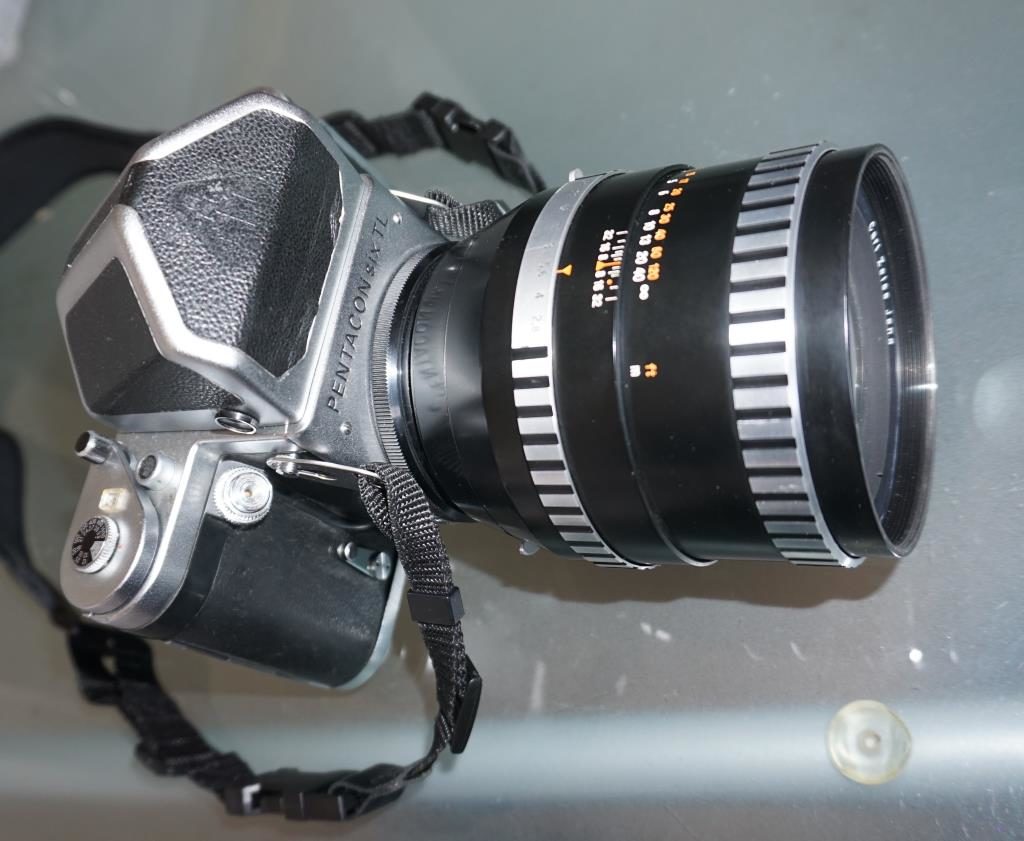
The tested Carl Zeiss Jena Sonnar 180mm f2.8 lens can also be used on inexpensive KIEV-60 and ARAX-88 medium format camera bodies with the Pentacon-6 lens mount. See the informative overview about lenses with the Pentacon-6 mount from Dr. Horton here: http://www.zachhorton.com
Otherwise, you have to live with the increased weight and size of medium format lenses compared to full frame lenses.
What crop factor applies to a medium format lens on a full frame camera?
A 180mm f2.8 medium format lens will behave like a 180mm f2.8 lens on a full frame camera regarding field of view and aperture value. The crop factor does not apply to lenses, only to cameras and sensor sizes! You can verify this fact by checking the field of view and shutter speeds in the sharpness test photos below between the medium format Carl Zeiss Jena Sonnar 180mm f2.8 and the competing two full frame lenses.
The highlights of the Carl Zeiss Jena Sonnar 180mm f2.8 (Zebra version tested on Sony a7ii)
- 1365g weight, 86mm filter, 7 aperture blades with spring iris
- Sharp from open aperture f2.8 in the center and from aperture f4 in the corner
- Perfect lens for shallow focus technique to create images with prominent out-of-focus regions. Notice the lens’ narrow band of depth of field scale:

- The focus point can be set beyond the infinity mark to compensate focus changes because of the fluorite glass element of the Sonnar lens in case of high temperature changes
- Good color rendering and medium contrast
- Soft and pleasing bokeh (see the photo gallery below)
- The single coated lens really needs the use of a lens hood to avoid heavy flares, also do not try to shoot against the sun
There are five main versions of this lens (approx. dates)
- 1936 to 1961: The original Olympia Sonnar with 18 blades aperture. Started in a silver design and changed to a black design after World War II.
http://allphotolenses.com - 1961 to 1966: Rhomb design, often referred to as “Star Wars edition“. Carl Zeiss Jena adapted the Olympia Sonnar for the 6×6 medium format and the Pentasix and later the Pentacon Six camera system. There was a significantly redesigned barrel with rhombs on the focus ring. The lens had a single layer coating and was reduced to 8 aperture blades to enable a spring iris.
http://allphotolenses.com - 1966 to 1974: Zebra design with 8 and later 7 aperture blades. Probably the best value for money on ebay and elsewhere because of image quality and pricing.
http://allphotolenses.com - 1974 to 1976: Black barrel design. Significantly reworked with 6 aperture blades and probably implemented production cost savings.
- 1976 to 1990: Black barrel design with “MC” multi-coating was added. Restarted serial numbers from 1001 in 1980.
http://allphotolenses.com
If you are interested in all versions of this lens, see the following document (sorry, German language only):
http://www.pentaconsix.com/
praktisix_zeiss_2.pdf
In 1978, Carl Zeiss West Germany started to produce Carl Zeiss Sonnar 180mm f2.8 lenses for the Contax/Yashica mount, but with a changed lens design and for full frame cameras only.
http://allphotolenses.com
Test procedure to compare the sharpness of the lenses
The following lenses were used to compare center and corner sharpness with the Carl Zeiss Jena 180mm f2.8 at f8:
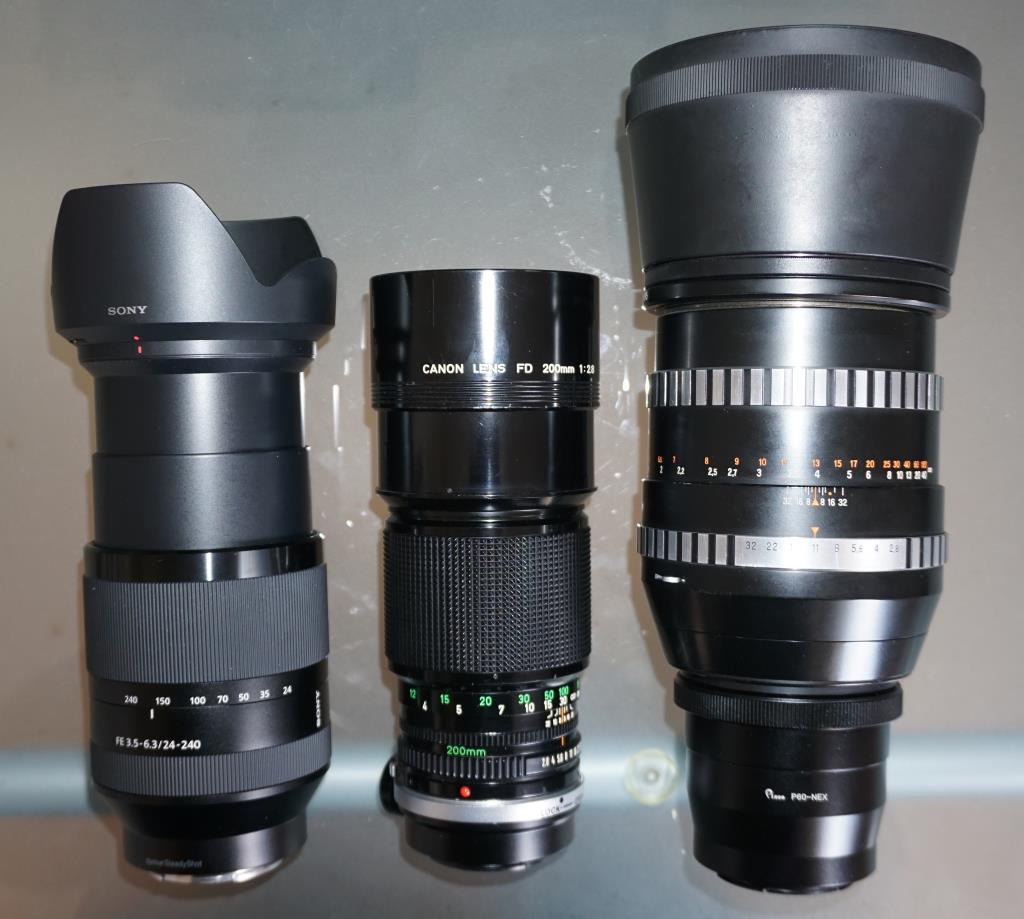
The Canon FD 200mm f2.8 lens was selected to compete with the Carl Zeiss Jena Sonnar because it is widely known as a decent sharp 200mm vintage lens for an acceptable price.
The modern Sony FE 24-240mm zoom e-mount lens was used at 180mm and f8 to have some kind of reference quality compared to the vintage lenses. See Ken Rockwell’s verdict about this modern zoom Sony FE 24-240mm lens here.

Camera used for testing the lenses: Sony alpha 7ii full frame mirrorless camera at ISO 100, several test photos were shot for each lens and aperture value to check a potential variation of test results. Focus peeking and max. focus magnification were used to carefully set the correct focus for the lenses.
Test photo comparison in center at f8
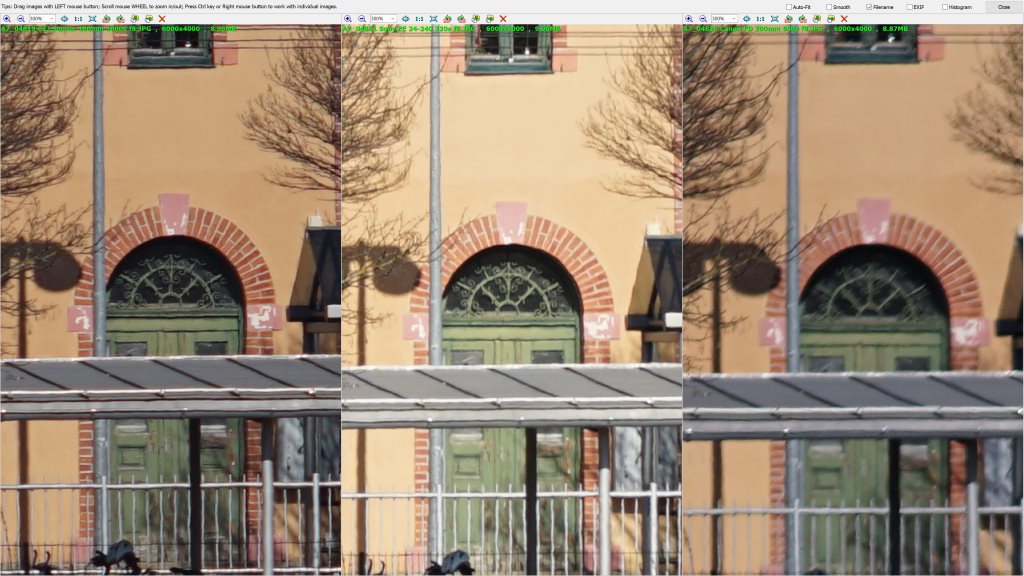
Test photo comparison in corner at f8
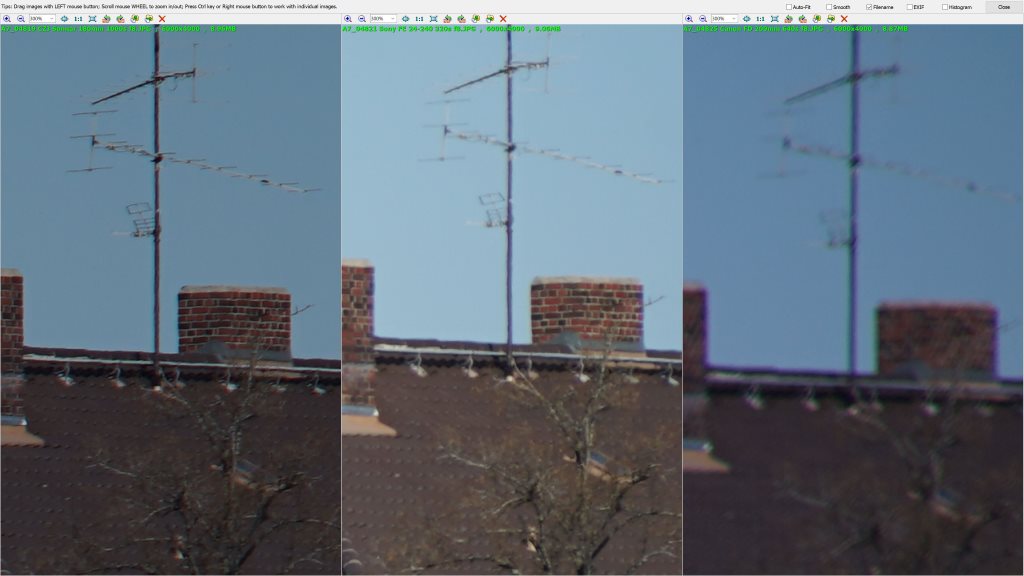
Sharpness test results
The test results show that the over-50-year-old Carl Zeiss Jena Sonnar 180mm medium format lens clearly outperforms both the modern Sony FE 24-240mm lens and the Canon FD 20mm f2.8 in center and corner sharpness.
Further reading
Read more about the honorable Carl Zeiss here:
https://en.wikipedia.org
Read more about the history of the Zeiss company here:
http://www.company7.com
Read more about the Olympic Games 1936 in Berlin here:
https://en.wikipedia.org
.
Digital photos on full frame Sony a7ii camera
.
Analog photos on medium format Pentacon Six camera
The analog film was a ILFORD DELTA 400 PRO 120 roll film.Look here for a review of the Olympia Sonnar 180mm f2.8 lenses made in West Germany vs. East Germany here:
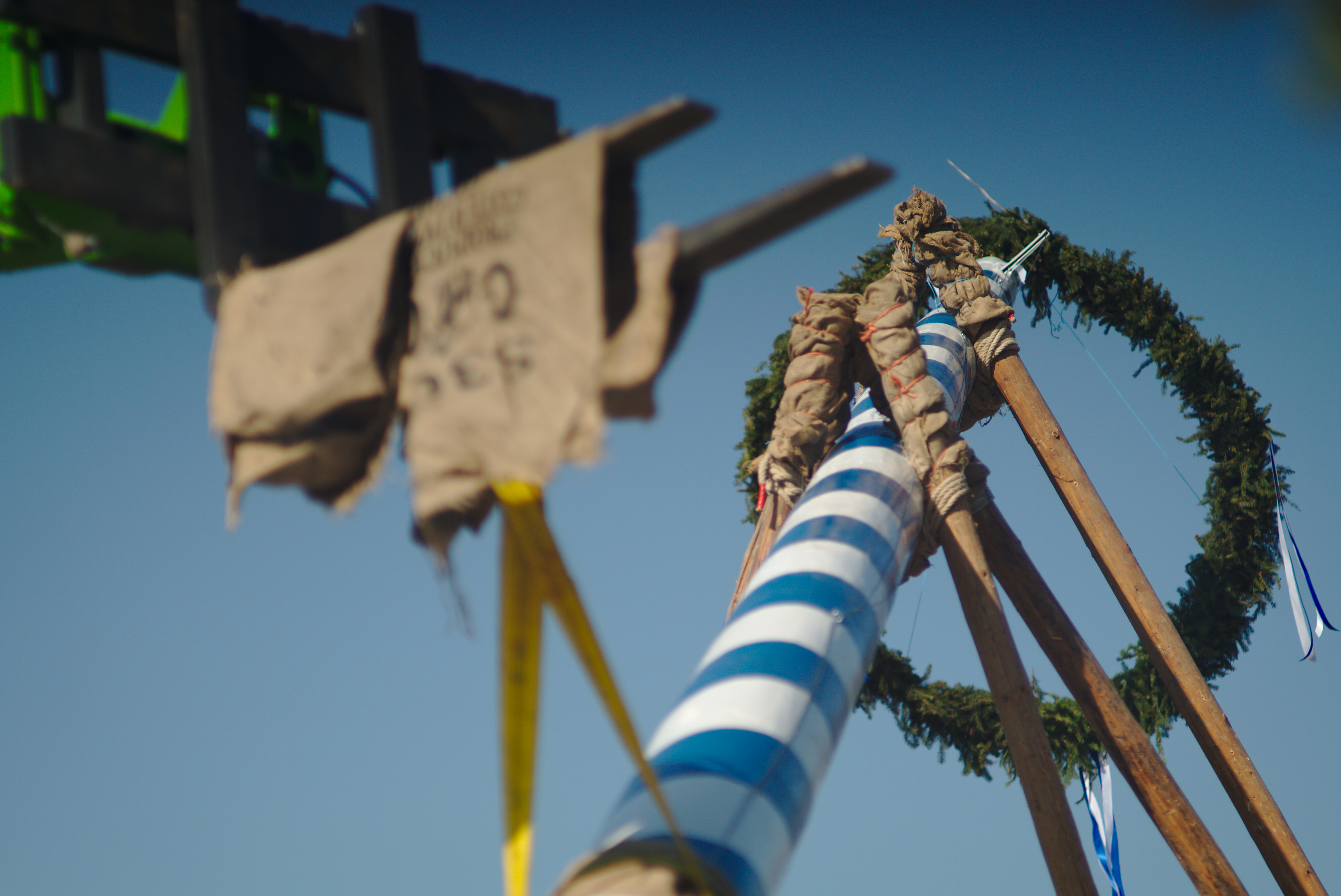

The original prewar Olympia Sonnar was a jewel. Not that big optically but also machanically perfect. I owned one in the sixties (which I mounted on a Bronica S camera). The mutiblade was beautiful and the brass helicoidal mount a marvel of precision. I do regret not having kept it. It would have been great on my Nikon digital.
By the way I also regret my Hermagis 150mm softfocus, though mouting it on a modern camera would have been more difficult, but the rending was different from anything I have seen since.
Just acquired an original 1936 (Nov.) direct Contax mount (not with reflex mount) by chance. #123 of the first 300. It needs a clean but – when I sell it on which I will, I’ll leave it to the buyer to find someone brave/good enough. There are not many of these genuine Olympic Olympias around as of the orginal 300, some were post-converted to the Flektascop reflex mount for easier use and some would have been lost in the war. Magnificent thing – and there is a Contax RF adapter available so I put it on my a7 III. I tried with a Contax II at first but is is hideously difficult to handle, especially with arthritis! 1.3kg of heavy metal and glass. Back then there was a genuine Zeiss rifle stock mount but that’s now even rarer than the lens.
It is hard to describe the result. I’ve used a Rhomb version on a Praktisix many years ago (8 blade) but this is different. Images seem to glow, it has the best bokeh I’ve ever seen and there’s an overall creaminess, typical Zeiss softness with high definition. The best portrait lens perhaps which why it was popular after the war I suspect as it was soon overtaken as a sports lens.
Hi Jean Paul,
I have just read your post regarding the Sonnar that you left with the Bronica. I have just purchased a Bronica S2a with full kit including 3 lenses, one of which is a silver Sonnar 2.8/180cm. The Sonnar has been converted to fit this Bronica. I am just wondering if this was your old lens! The serial number on it is 2404161. The lens is in remarkably good condition and even has the original silver lens cap with it. I realise it’s been a long time, but maybe you have a record or pictures of the lens!
I would love to know the history of this lens, but there’s very little information out there on these lenses.
What sort of price would I expect to get for this?
Any help you can give would be greatly appreciated.
Hi Jason,
My Sonnar 2.8/180mm has a ‘slightly’ different serial number. If you could email me some detailed photos of your Sonnar lens to ch(at)swiss-1.ch, I might be able to give you some more information about the history of this lens. After receiving some informative photos of your Sonnar lens, I may be able to also send you my personal guess of a price indication.
Kind regards